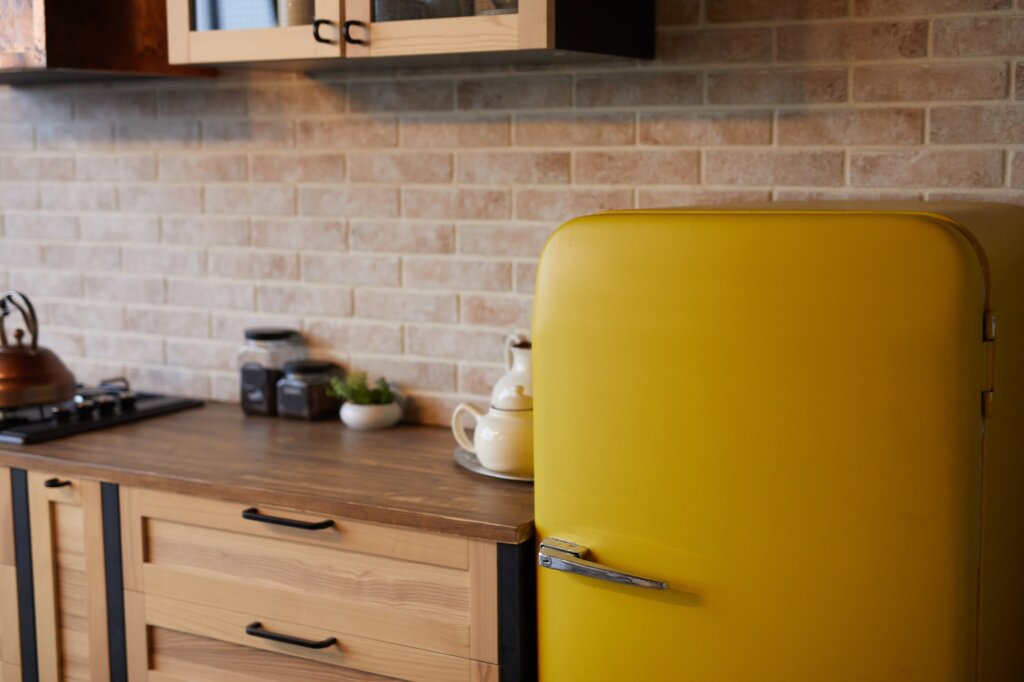There’s something undeniably comforting about stepping into a kitchen lined with honey oak cabinets, patterned tiles, and pastel-colored appliances. In 2025, nostalgia-infused design has reached a fever pitch: homes across the UK are embracing 90s kitchens, retro appliances, and vintage aesthetics. But this isn’t just a passing trend—it’s a profound cultural movement. Here’s why these throwbacks are resonating deeply—and how you can bring that timeless charm into your kitchen, whether you’re renting or renovating.
1. The Psychology Behind Nostalgia & Why It Works
Psychologists agree: nostalgia is not frivolous—it’s emotionally restorative. In a world saturated with fast-moving change, retro design provides stability, warmth, and a sense of continuity. According to Better Homes & Gardens, younger generations are drawn to old-school aesthetics as a counterpoint to digital overload and modern minimalism.
Homes designed with retro elements—whether it’s a avocado green fridge or a checkerboard floor—trigger fond memories, evoke warmth, and make spaces feel lived-in. This craving for comfort and familiarity is especially strong among millennials and Gen Z, who are reconnecting with cultural markers they grew up with—even if implicitly.
2. 90s Kitchens: Form Meets Emotional Function
Modern designers are embracing classic 90s kitchen features due to their functional layout and welcoming aesthetics. The Spruce notes that architects favor 90s footprints—complete with cozy, efficient plans, curved counters, and soft design lines.
What does that mean for modern living? Think less cold open-plan showpiece, and more warm gathering hub—spaces designed to anchor social routines and communal meals. These kitchens emphasize practicality and psychological “coziness,” making them ideal for families, roommates, or anyone craving authentic connection.
3. Key 90s Kitchen Trends Making a Comeback
Design experts have identified several 90s elements now revived in stylish, 2025-friendly aesthetics:
a) Checkerboard Floor Tiles
Black-and-white checkerboard floors, emblematic of timeless retro style, are making a bold return—now reimagined in sleek tile forms.
b) Stainless Steel Accents
Glossy stainless steel cabinets and appliances evoke professional kitchen vibes while offering durability and hygiene .
c) Glass-Fronted Cabinets
Lichtenstein-inspired reeded or fluted glass cupboards blend visibility with elegance—toning down clutter while keeping display charm.
d) Slab-Front Cabinetry & Handle-Free Design
Bold avocado-green or sleek slab-door finishes reference 90s minimalism but carry a modern aesthetic appeal.
e) Exposed Brick & Rustic Elements
Urban industrial meets nostalgic warmth—brick walls provide texture and timeless character.
f) Bold Tiled Backsplashes & Patterns
Busy geometric or checkerboard backsplashes inject 90s vibrancy, now filtered through contemporary design consciousness.
g) Appliance Garages
Hidden kitchen tech like mixers and toasters re-emerge to declutter countertops, styled for modern convenience.
These elements combine vintage charm with practical design, balancing therapeutic nostalgia and functional modern living.
4. Retro Appliances That Combine Style and Technology
Retro-styled appliances aren’t just cute—they’re functionally modern:
Brands like Big Chill, Smeg, and Crosley offer fridge and range lines in vibrant pastels and chrome details, merging classic 1950s aesthetics with contemporary tech. These appliances are fully compliant with current energy standards, ergonomically sound, and surprisingly small-space friendly—ideal for rentals or compact kitchens .
Interior designers caution consumers to check performance specs—like power, capacity, and maintenance—before splurging on authenticity over function .
5. Why 90s Nostalgia Matters in 2025
Several background forces elevate this trend:
- Newtro Culture: A global movement especially strong in South Korea, blends retro aesthetics with modern editing—embracing vintage structure with 2020s.
- Eco-Consciousness: Upcycling old fridges or salvaging 90s cabinetry reduces waste and highlights sustainability. Vintage appeal aligns with eco-aware design strategies .
- Comfort Over Minimalism: After years of sleek all-white interiors, people crave dimension, texture, and sincerity—qualities 90s kitchens deliver innately .
Mixing classic retro elements with contemporary efficiency offers both nostalgic warmth and fresh energy.
6. Tips for Incorporating 90s Vibes into Your Space
Trying to evoke retro charm without tipping into dated? Here’s how:
- Start Small – Use peel-and-stick tiles or swap knobs and handles for vintage designs .
- Choose One Statement – A checkerboard floor or pastel Smeg fridge anchors the nostalgia without overwhelming.
- Blend Modern with Vintage – Oak shelving or architect-style lights reference 90s roots while blending with modern cabinets.
- Think Functional – Appliance garages and built-ins keep retro looks while maintaining countertop space .
- Infuse Pattern & Texture – Reeded glass, tiled backsplashes, or brick walls layered with sleek counters add warmth and detail.
Pro Tip: If you’re renting or updating gradually, thrift stores or rental-friendly fixes—like colorful small appliances and removable tiles—are cost-effective ways to embrace trend elements.
7. Real-Life Inspiration: A Renovation Story
Designer Kate Marker Interiors recently reinvented a dated suburban kitchen by integrating three retro references: pastel blue cabinets, a hidden appliance garage, and a checkerboard floor. The result? A space that felt both distinctly ’90s and effortlessly timeless. The homeowner called it “like stepping into your childhood memories—without the dated feel.”
8. Balancing Form, Function & Emotion
Nostalgic design offers:
- Emotional payoff—warmth, familiarity, comfort, memory.
- Environmental sense—evidence-based mood-boosting features like wood tones and layered materials.
- Life adaptability—maximizing durability and tech integration while celebrating design heritage.
By preserving comfort and character, 90s design remains meaningful in a digital, fast-paced world.
9. Why Nezt Homes Embrace Retro Warmth
At Nezt, we understand how environment shapes experience—especially in temporary living:
- Many of our 1,300+ UK homes feature warm-toned cabinetry, integrated appliances, and vintage lighting, creating instant “home” vibes.
- Small retro accents—like pastel kettles, removable backsplash patterns, or classic tiling—systematically incorporated into decor help reduce emotional friction when staying short-term.
- Our style guidelines mix nostalgia and neutrality—balancing cozy personality and broad appeal.
Whether you’re staying weeks or months, these touches foster emotional comfort and ease belonging—without sacrificing flexibility or modern aesthetics.
10. Final Thoughts: Homes That Feel Timeless
Our fascination with 90s kitchens and retro appliances isn’t just trend-chasing—it’s instinctual. In a fragmented world, nostalgia functions as therapy. It provides warmth, security, and roots—even when uprooted.
Blending retro form and modern function is no longer hybrid—it’s holistic living. As we embrace future-ready design, we also cradle our psychological need for familiarity.
In the end, these kitchens feel like home—not because of the era they reference, but because they echo our emotional landscape.



